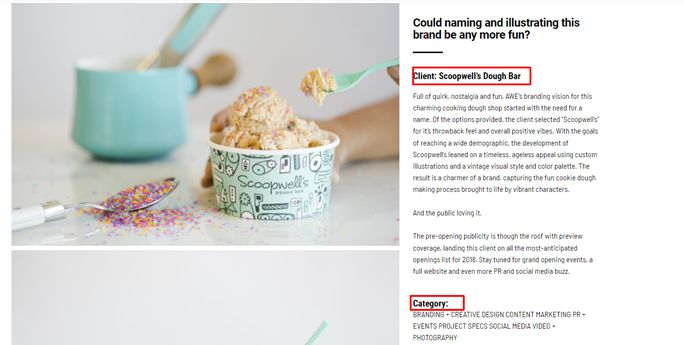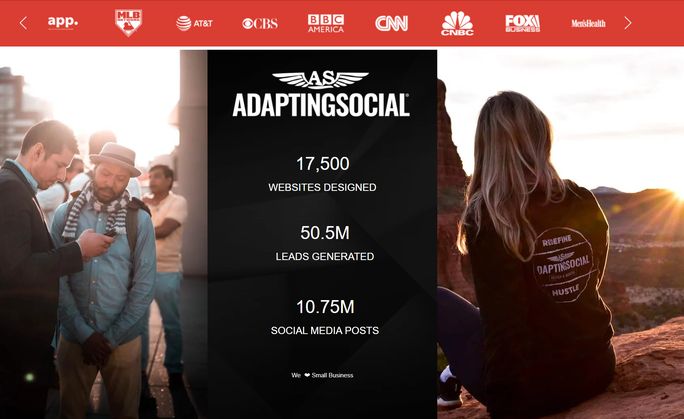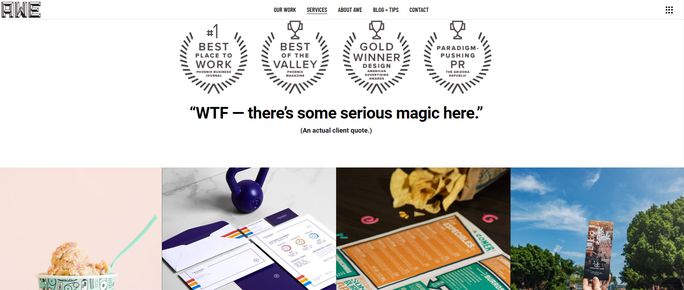Remember the adage: Don’t tell them, show them?
Well, that’s precisely what your potential clients expect from you. You need to show that you are worth every penny they have allocated for the marketing budget. Otherwise, they will move to the next marketing agency in the queue.
But how do you show that you have the required skillset and experience to nail the marketing goals of your prospects?
A marketing portfolio will do the job for you.
A marketing portfolio for an agency showcases the collection of your best client work relevant to your targeted prospects. It includes client achievements, awards, and professional success to demonstrate your agency’s skills and experience to bring forth results.
As a result, a well-crafted portfolio helps your client envision your agency in action.
Now, if you agree on the need to create a powerful first impression, let’s crack the code of creating a client-winning marketing portfolio.
Read on!
Why Do You Need a Marketing Portfolio?
The competition is cutthroat, and every agency can promote itself as a top-notch marketing support today.
Hence, the need for a digital marketing portfolio template is pretty evident for an agency.
Putting your value, skills, and expertise to potential clients through a portfolio increases the chances of making the prospect’s shortlist.
How do portfolios manage to do that? Here’s how:

Showcase Your Growth and Experience
Your portfolio is more than showing what you have done. It dives deeper into the numbers and shows how you did what you did to some extent. This helps prospects understand your working experience and the trajectory of your career.
Build Trust and Credibility
Trust is the keyword when it comes to starting a relationship with a potential client. A well-crafted portfolio with relevant client testimonials, case studies, and results can help sow that seed.
When your prospects see that you have worked with similar brands and achieved results, there will be a natural inclination towards choosing you as their marketing knight.
Having an online marketing portfolio is a great way to increase your brand authority in the industry. You can share your outstanding achievements on the portfolio page and share on social and other marketing channels for client acquisition and recruitment purposes.
What Should You Include in Your Marketing Portfolio?
Now, why did you start with the idea of creating a marketing portfolio in the first place? Of course, to impress your potential clients and get the business.
In order to do so, you need to touch the nerve of your prospects by showcasing the extraordinary work you have done with some of your clients.
So, the priority is to include your best and most recent work samples, case studies, awards, and accolades.
As your agency grows, so does your clientele, and with it, your marketing portfolio. Thus, it becomes vital that you keep updating your portfolio with new work from time to time.
A stale portfolio will send out the message that either your marketing agency is inactive or doesn’t know how to market itself (which is worse, considering your trade).
However, constant updates don’t mean you upload mediocre work. Only include client works impressive enough to get prospects pondering.
The proper way to register an extraordinary work in your marketing portfolio is by giving out the following information:
- Name of the client
- Offered services
- Campaigns you created
- Successful outcomes and findings (show the math)
- Testimonial from your client
- Awards and recognitions
Look how AWE Collective broke down information about their happy clients.

Besides the main body, covering the agency bio, contact information, and a suitable call to action that every marketing portfolio template includes is very important.
If you’re just starting or planning to scale, check out our guide on how to start a social media marketing agency for foundational steps before building your portfolio.
Hence, the need for a digital marketing portfolio template is pretty evident for an agency.
How to Make a Marketing Portfolio in 6 Steps
Step 1: Pick a Hosting Platform
The best way to present your marketing portfolio is on a website. Having a website makes you easily searchable and helps you look more professional and ardent towards business.
However, most marketers don’t have the necessary tech skills or the budget to create a custom website when starting. In such a case, using a website builder is the safest bet.
Website builders are hosting and website creation tools that provide designer-made templates that you can customize according to your needs with the help of drag and drop functionalities to make your online portfolio.
Here are the names of a few famous website builders:
On the other hand, if you already have a website, then move on to the next step to learn how to optimize it to make your portfolio visible.
Have you ever browsed through a website where you couldn’t find the exact thing you were looking for?
The experience is excruciatingly annoying. Don’t be that website.
Remember, your goal is to move website visitors to your portfolio page, and you only have a few seconds to grab your reason’s attention before they leave. So, don’t clutter your website with unnecessary content and flashy fonts.
Here are the best practices to create an easy-to-navigate marketing portfolio website:
- Create a sitemap
- Use descriptive, but short menu titles
- Avoid large images and long text
- Make words easily scannable
Look at the home page of Hive Creative Group with an easy-to-access link to get to the main portfolio.

Step 3: Create a Compelling About Section
An about section introduces the audience to your agency.
Your agency’s “Bio” or “About section” greets the visitors with your introduction and shares the values you bring to the table.
It’s essential to open your portfolio with solid words to exhibit your experience and background with a mission statement that your agency finds meaningful.

Step 4: Craft a Well-categorized Work Sample Canvas
Next comes the most exciting part of your marketing portfolio – your work sample canvas.
A work sample/case study canvas is a showcase of different projects with a short introduction and a fine-looking campaign collateral image or video.
You need to take care of two things while creating your work sample page/fold.
First, don’t show every campaign you have worked on. The goal is to impress your audience enough to click further and learn more about a specific campaign. Don’t waste their time. Choose your best work.
Second, segregate your campaign based on the different marketing services you offer or the industries you cater to. For example, if you provide multiple services ranging from social to website design, then provide proper segregation for each project. Similarly, give out a filter to check work samples from different industries.

Step 5: Write Informative Content
Next, dig deep into each project.
You can do it either by further elongating a work sample into a case study on a different page or by providing a brief explanation beside the work sample.
For each work sample, provide a clear description of the following things:
- The goal of the project
- Your role and responsibilities
- Challenges faced
- Solutions discovered
- Outcome
- Client testimonials
Basically, you will have to give a total overview of the project from start to finish.
Step 6: Show Visitors a Way to Connect
The end goal of a portfolio is to convert the traffic into buying your agency’s pricing packages, right?
However, all this won’t happen in one go. You will first need to build relationships by giving them a way to connect with you.
The best time to do it is when your prospects are most impressed by you. And that time is right after seeing your awesome portfolio.
So toward the end of your page, you must provide a call to action.

You can do it by either giving out inquiry forms or by taking the nurturing route to sign visitors up for your newsletters. To do so, you need to give a strong call to action that entices visitors to take action.

Moreover, you can make your contact information, such as phone numbers or email addresses, easily visible so that your prospects can directly connect with you after going through the portfolio.
You should also include links to your prominent social channels to maintain a channel of connection with your prospects, even after they leave your website.
How to Showcase Your Agency Marketing Portfolio?
All the great work your agency has been doing is now made into a fine-looking online portfolio.
Now, where should you put it? Of course, it’s an online portfolio, so it will be on your website…but where?
We have already discussed the need to create an easy-to-navigate website so your potential clients can easily reach your portfolio.
The best way is to create a separate page for a portfolio and put a link to it in the website navigation menu.
It’s necessary because some clients may prefer downloading the PDF version of the portfolio to share with the in-house stakeholders. With a separate portfolio URL, the sharing part becomes easy and eliminates the need for a PDF.
Putting further emphasis on it, I’d recommend creating a separate page for each case study with a link included to your full portfolio.
4 Inspiring Marketing Portfolio Examples
Still confused about what your portfolio should look like?
Don’t worry; we have curated a list of the best marketing portfolio examples that will inspire you to create your own winning marketing portfolio.
1. Hive Creative group

Hive Creative Agency is a full-service marketing and design agency with a website that instantly catches your eye. The homepage animated icons, which appear throughout the website, take the spotlight for me.
Their portfolio is segregated based on the different services they provide, which further opens up to sharing each client’s work samples.
What’s good?
- Compelling design and fonts
- Consistent use of brand colors
- Well segregated portfolio
- Compelling outcome tile in the portfolio
- Easily accessible contact details and social media icons

The home page of Adapting Social showcases its most significant clients and proudly shouts out the agency’s success by providing the shimmering results achieved upfront.
Their portfolio page titled “what we do” stood out to me the most. It is elegantly broken down into different service categories, such as lead generation, email marketing, and graphic design, so visitors can quickly check out the services they are interested in.
What’s good?
- Consistent use of branding colors
- Correct breakdown of the portfolio
- Effective showcasing of achievements
- Great client and service request forms
3. Desk

Desk is a boutique creative agency assisting brands with visual design and communication. The use of grey and white shades on the homepage of Desk makes the overall user interface very soothing.
The works sample canvas includes appealing images of previous projects that visitors can’t resist clicking.
However, the thing that sticks out is the elegant agency bio.
What’s good?
- Proper use of fonts
- Decent colors
- Compelling bio fold
- Amazing work sample images
- Perfect call to action
4. Awe Collective

Just like the agency name, the portfolio design of Awe Collective is awe-inspiring. If your agency has received any awards or accolades, then take a leaf from Awe Collective’s book and use an award fold on the homepage as they did.
Moreover, the dynamic design of the portfolio perfectly breaks down the plethora of services offered by the agency and further uses it to elaborate on the work samples.
What’s good?
- Effective background video
- Good, Effective showcasing of awards and accolades
- Easy breakdown of work samples
- Eye-catching newsletter call to action
- Elaborative case studies
To Sum it Up!
Your clients are looking everywhere to find an agency to realize their business through marketing.
End their search on your website with a solid marketing portfolio.
A well-crafted marketing portfolio will help you get more inquiries and eventually aid in winning more clients.
With the detailed steps mentioned above, you will easily create a client-winning marketing portfolio.
Speaking of easy, don’t hesitate to use SocialPilot’s unparalleled scheduling, analytics, and content curation functionalities to automate social media marketing for your clients.
Experience it yourself! To know more, start your free trial or schedule a demo now!



